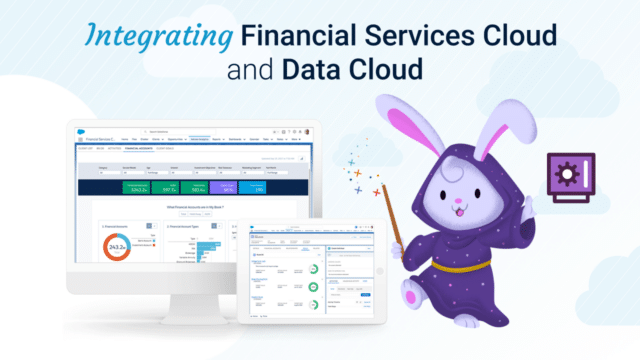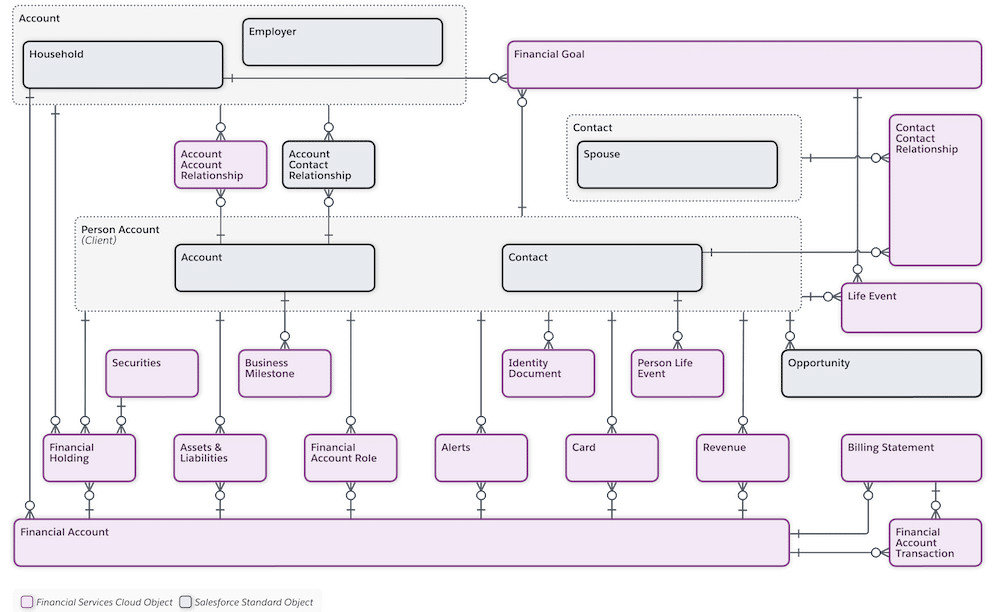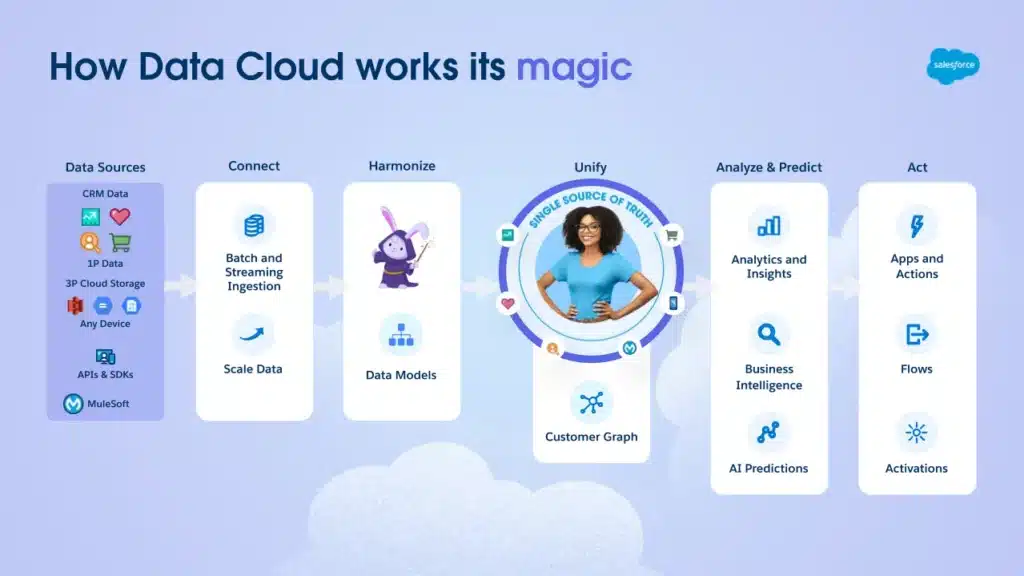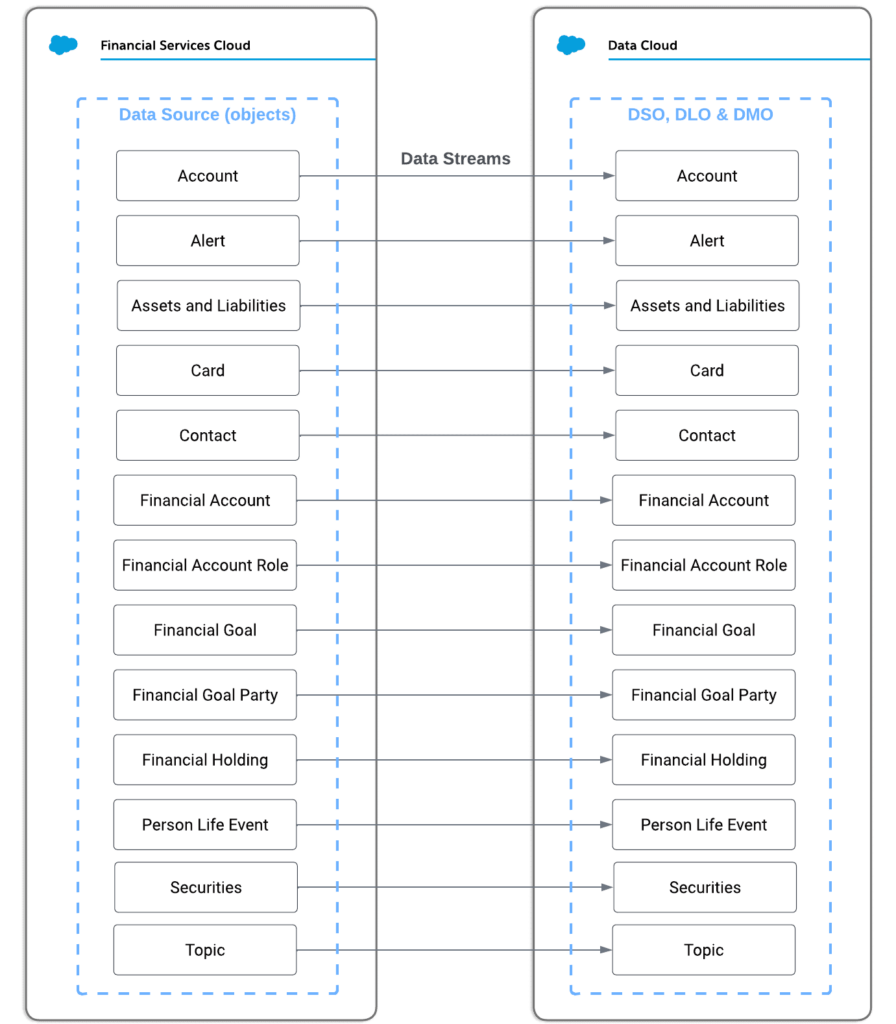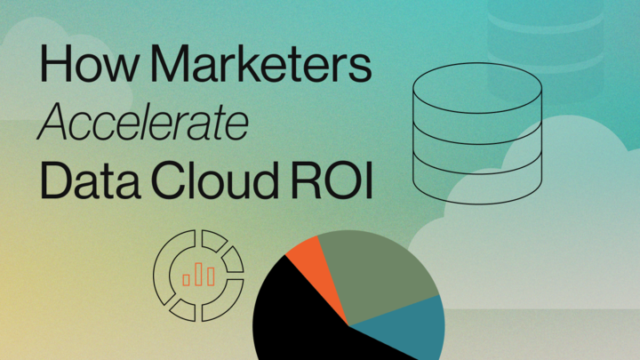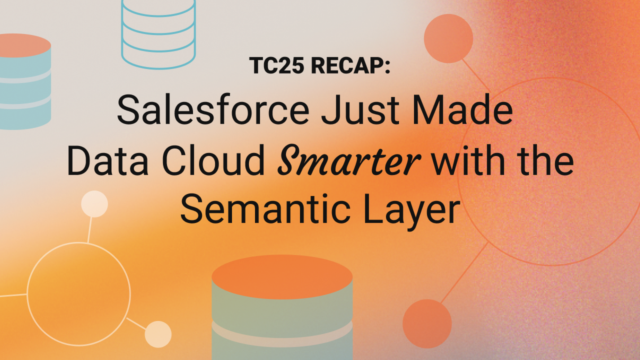The Customer Data Problem
The vast majority of Financial Services organizations today share a common problem: customer data is siloed across departments and systems. Imagine an investment firm that offers a portfolio of financial products like mutual funds, stocks and retirement planning services. Information about these various products typically reside in separate (and typically proprietary) databases. Without an integrated view of all of the customer’s interactions, the firm may struggle to provide their customers with appropriate, timely, tailored investment solutions and recommendations. Furthermore, these data silos typically don’t integrate with other customer touchpoints, like websites or digital marketing platforms.
Financial Services Cloud
Financial Services Cloud (FSC) is Salesforce’s industry solution to address many of the challenges that Financial Services firms face, including retail & commercial banks, insurance companies, and wealth managers. With Financial Services Cloud, companies have a powerful platform to increase engagement, deepen their relationships and expand their offerings with customers. However, like any tool, Financial Services Cloud is only as powerful as the quantity and availability of the data within it.
The FSC data model builds on the core object model from Salesforce CRM by including a ‘Financial Accounts’ object which is used to model a customer’s financial holdings with a financial institution, like a bank. These can include many different account types, including checking accounts, savings accounts, mortgages, credit cards, investment accounts, 401(k) accounts, and insurance policies. Similarly for an Investment Advisor, this can include Mutual Funds, Stocks and Retirement Plans.
Additionally, dozens of other objects are used to define cardinal relationships between a Financial Account, the household, customer and financial goals as indicated in the entity relationship diagram below. And additional data entities exist to describe and store data for related subject areas like insurance, financial deals, mortgages, consent and more.
While a single platform that can model, store and present this information is an important part in understanding customers, it does not provide a complete customer view on its own.
Data Cloud
Data Cloud is a purpose-built platform that enables organizations to connect all their customer data, at scale. Whether that data resides in a mobile app, data lake, data warehouse, Salesforce platform, or is collected from user interactions on your website, Data Cloud provides the ability to ingest data from multiple sources, either as a batch process or in real-time, then harmonizes the data into a structured, canonical data model and applies reconciliation rules to unify individual records to single profile that adapts to a customers’ activity and behavior. Then you can analyze, segment and activate this data, automating customer experiences across the complete suite of Salesforce Customer 360 products.
And for the financial services industry, the ability to connect, harmonize and process voluminous data at scale unlocks a multitude of use cases that were previously unattainable.
While FSC solves many industry challenges, it’s not a silver bullet. But unifying data and insights from FSC together with customer data from other platforms — for example, core banking, web and mobile, in-branch systems and digital marketing platforms — not only enables a complete customer view, but more importantly, as this data is unified, it can provide actionable insights to facilitate a cohesive customer experience across touchpoints and channels.
Data Cloud and Financial Services Cloud
Data Cloud includes a comprehensive library of data objects spanning many different financial services subject areas and use cases to create a comprehensive Customer 360 Data Model. Additionally, this support includes:
1. Pre-built data mappings and data streams to FSC objects (using a Data Kit)
2. Pre-defined Calculated Insights for common financial services use cases
3. FlexCards to visualize calculated insights and trends from Data Cloud in FSC
In order to use these FSC components in Data Cloud, you will need the FSC Intelligence SKU provisioned on your account. Contact your Salesforce account representative for more information.
Integrated Data Model
Once the Salesforce CRM Connection is enabled (in Data Cloud Setup) and other prerequisite steps have been completed as documented on Salesforce Help, you can install and deploy the FSC Data Kit then deploy FSC Data Streams to Data Cloud. Supported objects in the kit and data stream connection to the respective Data Cloud objects is indicated below.
In addition to the connected FSC object data, it’s recommended to connect customer transactional data, for example, from a core banking platform, as this data not only supports common activation and segmentation use cases in Data Cloud, but also enables pre-built calculated insights to be used for building multidimensional metrics from transactional data.
A Financial Account Transaction data model exists in Data Cloud for this purpose (as both a DLO and DMO). Supported attributes are listed below. Connect a transactional data source to Data Cloud using an available connector, then map the fields to the respective DLO attributes (below).
- Acquiring Bank Name
- Authorization Record Text
- Card Scheme Name
- Cash Flow Type
- Currency
- Description
- Financial Account ID
- Financial Account Transaction Status
- Financial Account Transaction Type
- Forex Conversion Charge Amount
- Id
- Issuing Bank Name
- Merchant Category Code
- Merchant Name
- Name
- Running Balance Amount
- Secret Key Identifier
- Source System Identifier
- Source Transaction Identifier
- Source Transaction Type Code
- Target Account Identifier
- Transaction Amount
- Transaction Date
- Transaction Location Name
- Transaction Posted Date
- Financial Transaction Category
Calculated Insights
The FSC Data Kit includes a total of 26 pre-built calculated insights for popular trend analysis use cases. This data can then be used as an individual profile, segment, or population level for audience segmentation or business intelligence use cases. Furthemore, these metrics can be visualised at a record level in FSC using FlexCards. Included calculated insights are listed below.
- Deposits for 3 Months
- Deposits for 6 Months
- Deposits for 1 year
- Expenses for 3 Months
- Expenses for 6 Months
- Expenses for 1 Year
- Average Monthly Expenditure Cover
- Credit Card Use Ratio
- Financial Account Balance Net Worth
- Financial Account Balance Wallet Share
- Held Away Financial Account Balance
- Large Deposit
- Large Expense
- Managed Financial Account Balance
- Monthly Expenses by Category
- Monthly Inflow Transactions
- Monthly Deposits by Category
- Percentage of Assets to Liabilities
- Percentage of Cash Inflow Spent
- Total Annual Expenses
- Total Monthly Deposits
- Total Monthly Expenses
- Total Number of Accounts
- Total Outstanding Credit
- Total Expenses by Month Last 12 Months
- Total Deposits by Month Last 12 Month
FlexCards
OmniStudio FlexCards enable users to build customer-centric, industry-specific UI components and applications in Salesforce. Data Cloud supports displaying calculated insights on FlexCards to enable users to identify client transactions, income, expenditures, and net worth. Supported FlexCards include:
- Client transactions to keep on top of client transaction trends on person accounts
- Client income and expenses to view a client’s cash flow trends over time. This FlexCard indicates incoming and outgoing transactions, highlighting cash flow trends and can be used to review metrics over time (on a bar graph) related to income, expenses and surplus.
- Client cash flow by category to review client’s income and expenses for the previous month grouped by category. The FlexCard displays client sources of income and expenses with a pie chart to show a breakdown of the top five outgoing or incoming transaction categories for the previous calendar month.
A Monumental Step Forward
The integration of Financial Services Cloud and Data Cloud unlocks new sales, service, marketing and business intelligence use cases that were previously unattainable out-of-the-box in either platform.
Harmonizing data from client financial accounts with transactional data, together with behavioral data from other customer touchpoints, including website, mobile app and email, not only unlocks customer insights and revenue through cross-selling and upselling opportunities, can be used to deliver a unified customer experience across channels.
Customer service has historically been a fragmented customer experience in financial services, but the ability to share calculated insights back from Data Cloud to Financial Services Cloud (using FlexCards) provides banking staff and financial advisors with aggregated transaction data and account analytics which were previously very hard to attain.
While the ability to create data streams in Data Cloud from FSC object and share calculated insights to FlexCards has existed all along (even prior to the FSC Data Kit), this has previously required significant custom development. The recent integration of FSC with Data Cloud marks a significant advancement in platform maturity as it enables users to integrate both platforms with minimal effort and is a monumental step forward, not just for Salesforce, but also for the financial services industry as a whole.
